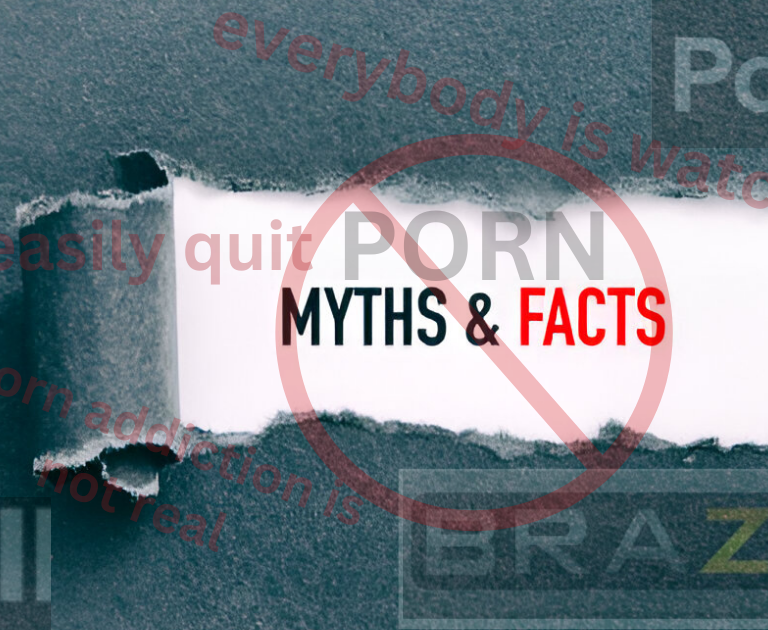Pornography is everywhere. But how much do we truly understand about it? Beneath its mainstream acceptance lies a web of myths that distort our perceptions and keep us trapped. Some of these myths may even fuel habits you never intended to form. Today, we’ll debunk the most common myths about pornography and reveal how breaking them could be your first step toward recovery.
Download a free ebook to quit porn for good
Myth #1: “Porn Addiction Isn’t Real”
Some argue that porn addiction doesn’t exist because major health organizations haven’t classified it as a formal disorder. However, this doesn’t mean heavy porn use lacks consequences. Many people feel stuck in compulsive patterns, often accompanied by shame and self-criticism.
Porn use triggers a dopamine “rush,” creating dependency-like cycles similar to drug addiction. Research shows that excessive consumption activates reward pathways in the brain, reinforcing habits that feel hard to break. Without addressing these patterns, casual use can spiral, especially during stress-filled periods when porn becomes a coping mechanism.
Takeaway: The billion-dollar porn industry won’t highlight the struggles users face, but understanding the addictive cycle is crucial to breaking free.
Myth #2: “I Can Quit Anytime I Want”
Porn consumption often becomes a habit, deeply wired into the brain’s reward system. Each viewing session releases dopamine, reinforcing the behavior and making it easier for your subconscious to seek out porn during stressful moments.
This automation makes quitting difficult. Relying solely on willpower usually isn’t enough. Breaking free requires strategies that rewire neural pathways and introduce healthier coping mechanisms.
Takeaway: Over time, excessive porn use builds ingrained habits that are challenging to overcome without intentional effort and the right tools.
Myth #3: “Watching Porn Causes Blindness”
This age-old myth has no scientific foundation. It likely originated as a scare tactic to deter young people from exploring sexual content. However, excessive screen time—whether for porn or other media—can strain your eyes, causing dryness, blurred vision, or headaches.
While porn won’t make you go blind, its real impact is psychological. Heavy use often disrupts personal relationships, emotional health, and self-perception.
Takeaway: Ignore the urban legends and focus on the genuine emotional and psychological effects of prolonged porn use.
Myth #4: “Rebooting and NoFap Will Solve the Problem”
Challenges like NoFap have helped many take a break from porn, but they often fail to address the root causes of addiction. Abstinence alone won’t resolve deeper emotional struggles such as anxiety, depression, or unresolved trauma.
True recovery goes beyond avoiding porn. It’s about healing, self-discovery, and building resilience against the triggers that drive compulsive behaviors.
Takeaway: Sustainable recovery involves therapy, mindfulness, and support systems that address emotional and psychological factors, not just surface-level habits.
Myth #5: “Porn Causes Sexual Dysfunction”

Many believe that porn directly causes sexual dysfunction, such as erectile dysfunction (ED) or delayed ejaculation (DE). While excessive porn use can impact mental well-being, scientific evidence doesn’t conclusively link it as the sole cause of sexual issues.
Sexual performance depends on a mix of physical, mental, and emotional factors. Unrealistic expectations from porn can lead to performance anxiety, further exacerbating insecurities. Lifestyle elements like sleep, nutrition, and stress management often play a much larger role in sexual health.
Takeaway: Sexual dysfunction is typically caused by multiple factors. Addressing mental well-being, physical health, and relationship dynamics can lead to lasting improvements.
Myth #6: “Porn Is the Only Problem—Once I Quit, Everything Will Be Perfect”
Excessive porn use is often a symptom of deeper issues, such as stress, anxiety, or trauma. Simply quitting won’t resolve these underlying struggles. True recovery requires exploring and addressing the emotional needs driving the behavior.
Therapy, meditation, and self-hypnosis can uncover hidden causes and transform the recovery process into a journey of self-discovery.
Takeaway: Lasting change comes from addressing root causes, not just eliminating the surface-level habit.
Myth #7: “Porn Doesn’t Affect My Relationships”
Porn can severely damage relationships by fostering unhealthy comparisons and eroding genuine intimacy. With instant gratification just a click away, real-world relationships may feel less fulfilling or rewarding.
When partners discover secretive porn use, they often feel betrayed or inadequate, which can shatter trust. Open communication and a willingness to tackle these issues head-on are essential to preserving healthy relationships.
Takeaway: Porn use can harm trust and intimacy. Addressing these challenges openly strengthens bonds and prevents lasting damage.
The Path to Recovery
Overcoming porn addiction is possible. It’s a journey of healing, self-discovery, and building healthier ways to cope with life’s challenges. You don’t have to do it alone—resources and support systems are available to guide you every step of the way.
Ready to take the next step? Visit our Porn Addiction Treatment Guide for actionable advice and strategies to regain control of your life.

